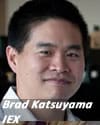IEX, the world’s most talked-about new trading platform, is not planning on bringing its business to Asia. The firm has no current ambitions to grow in Asia, unlike a number of competitors.
“We don’t have any plans yet for Asia Pacific, though it could be a possibility down the line. We are getting lots of enquiries from various countries,” said Brad Katsuyama, president and CEO of the IEX Group, the business development of which was chronicled in the recent Michael Lewis book, Flash Boys.
He was appearing at the FIX Trading Community’s 12th Asia Pacific Trading Summit.
Katsuyama said that there are 45 dark pools in the USA of which 44 are owned by brokers and one by the buy-side.
He explained that IEX has four order types, one fee type, no rebates or tiered pricing. He added that there was a 350 micro-second speed bump to ensure that no participant can get an advantage.
80% of trades at IEX are happening at the mid-point. Volumes six months ago were a few million shares per day and by March 2014 had risen to 35 million per day. He said that there remained a huge number of buy-side firms they have not yet connected with.
He said there were a very small number of high-frequency trading firms on IEX. The company subsequently confirmed that there are several independent HFT firms trading, including Virtu Financial, GTS and Sun Trading.
“They have been benign and good participants,” said Katsuyama. “Rumours that they account for 40% of volume on IEX is untrue, they account for 10%-15%. Our biggest users are bulge bracket firms.”
He said that among the reasons why IEX had been established were the excessive market fragmentation and inadequate transparency, which IEX planned to remedy.
“Everything in IEX has been done in the current rule set. The worst thing that could happen would be more regulation. We are pro-market rather than pro-regulation.”
Not all delegates perceived IEX as the next generation of global trading.
John Fildes, the CEO of Chi-X Australia, said that IEX was nothing new, pointing out that market structure in Asia is, in any case, different to the US. He said that no market pays rebates in Asia and only Japan, India and Australian markets are fragmented, there is no race-to-zero in latency, and therefore no IEX style speed bumps are needed, as Asian markets already have longer latency.
“If Hong Kong were to open up to competition, we would be here in a flash,” he said.
Ned Philips, the CEO of Altex Advisory, wondered if those present in the audience who had read Flash Boys thought that IEX was an exchange or actually a dark pool. The answer is: dark pool, though it is easy to mis-construe from its naming and the tone of the text that it is an exchange rather than an alternative trading system.
Philips was one of a triumvirate of three experts, seated on a raised dais at the conference, along with Kent Rossiter of Allianz Global Investors and Brooke Teeter of Tower Research Capital. Their role was to offer insights, ask penetrating questions (and occasionally, heckle the speakers). Philips mentioned off-stage that Asia will witness other new arrivals to the trading markets such as M-DAQ. the FX equity platform and Blue Ocean, the exchange-traded fund platform.
